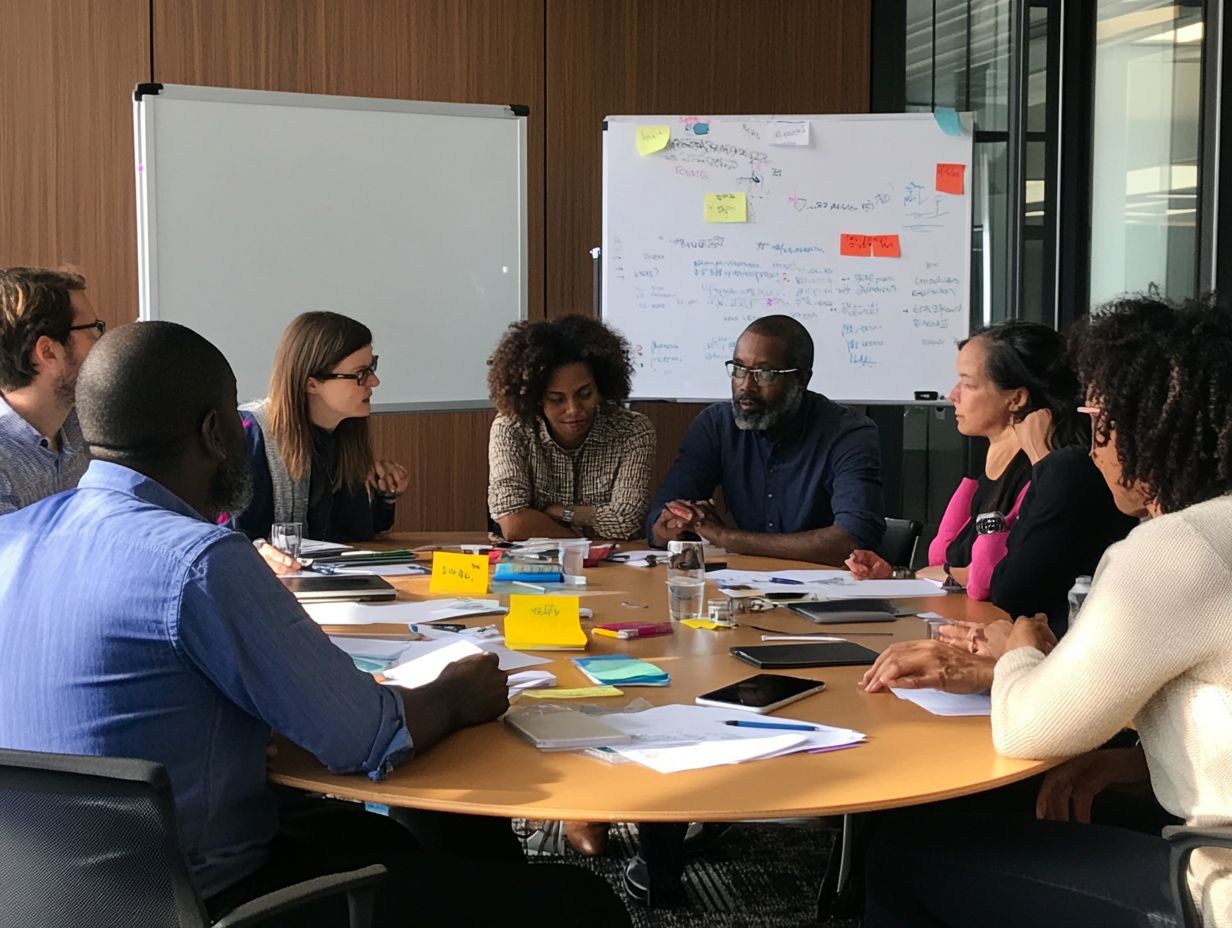Understanding Your Audience’s Pain Points
In today’s fast-paced world, recognizing and addressing pain points is essential for effective communication and problem-solving.
Whether you re a business owner, a student, or a parent, you face unique challenges that can hinder your progress. This article explores pain points and their significance.
You’ll discover common pain points across different groups and find strategies to address them with empathy. You’ll also learn how to measure the impact of your solutions to ensure meaningful change.
Keep reading to learn how to connect deeply with your audience and make a positive impact!
Contents
- Key Takeaways:
- Identifying Pain Points
- Understanding the Unique Problems Different Audiences Face
- Addressing Pain Points
- Empathizing with Your Audience
- Measuring the Effectiveness of Addressing Customer Challenges
- Frequently Asked Questions
- What are customer challenges?
- Why is it important to understand your audience’s challenges?
- How can I identify my audience’s pain points?
- What are some common pain points that audiences experience?
- How can I address my audience’s pain points?
- What are the benefits of addressing my audience’s pain points?
Key Takeaways:

- Understanding your audience’s pain points is crucial for effective communication.
- Business owners, students, and parents may face different challenges, but all can be resolved with empathy.
- You can measure the impact of addressing pain points through feedback and improved relationships.
Identifying Pain Points
Identifying pain points is vital for businesses aiming to engage meaningfully with their target audience. A deep understanding of the specific challenges your customers face can help you create marketing messages that resonate.
This requires looking at customer feedback and doing market research. Using social media to listen to customers ensures you’re addressing their pressing issues.
By identifying these pain points, you enhance customer satisfaction and set your brand apart.
What are Pain Points?
Pain points are specific challenges or issues customers encounter. They can include financial, productivity, process, and support pain points.
Understanding these areas helps businesses create solutions that improve overall satisfaction and loyalty. For example, financial pain points might include high costs or unexpected expenses that lead customers to seek cost-effective options.
Productivity pain points often arise from inefficient workflows, making it hard for customers to meet deadlines. Process pain points include tricky steps that frustrate customers, while support pain points highlight the need for reliable help when issues arise.
Addressing these pain points allows businesses to tailor their offerings and foster stronger relationships.
Why are They Important to Understand?
Understanding your customers’ pain points gives you the power to craft targeted marketing strategies. By pinpointing their frustrations, you can tailor your products to meet their needs.
This understanding enhances their experience and builds loyalty, making them feel valued. With this insight, your customer service can improve, allowing representatives to tackle concerns proactively.
By empathizing with your customers, you can create innovative solutions that boost satisfaction.
Addressing pain points leads to meaningful interactions, increasing customer retention and brand loyalty in today s competitive marketplace!
Understanding the Unique Problems Different Audiences Face
Different audiences encounter unique problems customers face shaped by their specific needs, challenges, and contexts. For instance, business owners might struggle with financial constraints and productivity hurdles. Meanwhile, students often face challenges related to their studies.
By recognizing these distinctions, you can create tailored buyer personas and marketing strategies that meet the needs of each audience. Identifying these problems allows businesses to enhance customer experiences and build lasting loyalty with their customers.
Business Owners

As a business owner, you’re likely facing specific problems that revolve around financial and productivity challenges. These can impede your growth and operational efficiency.
These challenges come in many forms and can really hold you back! For example, budget constraints might limit your ability to hire skilled personnel or invest in critical technology. Problems in how work gets done might lead to missed deadlines or client dissatisfaction, adding to your frustrations.
To tackle these issues, consider embracing innovative solutions like automation and smart resource allocation to significantly boost your productivity. Developing a strong financial strategy can give your business the stability needed for expansion.
By implementing these strategies, you can create a supportive environment that addresses your current challenges and positions your business for sustainable success in your industry.
Students
Students often encounter significant problems in their educational journeys. They grapple with issues like time management, resource availability, and engagement strategies in their learning experiences.
These challenges can leave you feeling overwhelmed and unsupported, ultimately impacting your academic performance and overall satisfaction. For instance, poor time management leads to increased stress and lower grades. Insufficient access to resources can impede your ability to complete assignments effectively. If engagement strategies aren t tailored to your diverse learning styles, you might feel disinterested or disconnected from the material.
Educational institutions need to introduce flexible scheduling options, enhance access to online resources, and develop innovative teaching methods that resonate with a wider range of students. By prioritizing these changes, they can significantly elevate the learning experience and foster greater academic success for everyone involved.
Parents
Parents often navigate a complex landscape filled with the demands of childcare, educational needs, and the challenge of balancing family life with work commitments.
These challenges can sometimes feel overwhelming, contributing to stress and affecting the overall well-being of the family. This presents a valuable opportunity for businesses to tailor their services and products to better support parents.
For example, offering flexible childcare services that adapt to varying work schedules can ease some of the logistical burdens parents face. Additionally, educational tools designed to accommodate different learning styles can help ensure that children thrive academically.
Providing resources such as workshops on work-life balance or digital platforms for parental support can empower families, fostering a more harmonious atmosphere at home. By understanding and responding to these specific needs, businesses can play a crucial role in enhancing the daily lives of parents.
Addressing Pain Points
Addressing pain points effectively requires you to develop targeted solutions and marketing strategies that resonate with your customers’ unique needs. This approach not only meets their specific challenges but also enhances their overall satisfaction, creating a more meaningful connection with your brand.
Let s tackle these issues together and create solutions that make a real difference!
Strategies for Addressing Customer Challenges
Developing effective strategies to tackle customer challenges requires you to deeply understand customer experiences. It also involves implementing targeted engagement techniques. This approach goes beyond merely analyzing feedback; it s about actively listening to your customers and pinpointing the specific challenges they encounter.
Prioritizing personalized communication helps forge meaningful connections that resonate with your audience. This ensures they feel valued and understood. Streamlining services is equally important. Simplifying processes and reducing friction can significantly enhance the user experience.
Proactive customer support anticipating needs and addressing potential issues before they arise builds trust and loyalty. By leveraging these strategies, you can dramatically improve client satisfaction and pave the way for long-term business success.
Empathizing with Your Audience

Empathizing with your audience is crucial for addressing their challenges. By truly understanding their frustrations, you elevate the level of engagement and connection. This creates a more meaningful interaction that resonates with them on a deeper level.
The Importance of Empathy in Addressing Customer Challenges
Empathy is essential for you to truly grasp your customers’ challenges. This enables you to respond more effectively to their needs and enhance their overall experiences.
When you prioritize empathy, you not only tackle issues with intuition but also cultivate stronger, trust-based relationships with your customers. For example, a well-known online retailer revamped its customer support system to focus on empathetic listening. The result? A remarkable boost in customer satisfaction scores.
By training representatives to actively listen and acknowledge customers’ emotions, they transformed challenging interactions into opportunities for meaningful connections, directly enhancing customer loyalty.
Integrating empathy into your business culture can unlock your team’s potential for creative and effective collaboration. This approach often leads to innovative solutions that resonate deeply with your audience, setting you apart in a crowded marketplace.
Measuring the Effectiveness of Addressing Customer Challenges
Measuring the effectiveness of addressing customer challenges is crucial for evaluating how well your solutions are making an impact. It allows you to identify areas for improvements, ensuring that your business continually evolves and meets the needs of your clients effectively.
How to Measure the Impact of Addressing Customer Challenges
To truly measure the impact of addressing customer challenges, focus on customer satisfaction metrics. Gather comprehensive feedback to evaluate how well your solutions are performing.
This means employing various methods, such as surveys to capture direct responses from customers about their experiences, product reviews providing valuable insights, and engagement statistics revealing patterns in customer interaction with your product.
By analyzing these diverse data points, you’ll gain a clearer understanding of where improvements are needed and how effectively your solutions align with customer needs.
In this context, continuous improvement is essential. The trends illuminated by these metrics can guide you in making iterative adjustments to your products or services. This ultimately enhances customer satisfaction and fosters loyalty.
Frequently Asked Questions
What are customer challenges?

Customer challenges refer to specific problems, difficulties, or frustrations that your audience is experiencing. They are the issues that your product or service can help to solve.
Why is it important to understand your audience’s challenges?
Understanding your audience’s challenges helps you identify their needs and motivations. This enables you to tailor your messaging and offerings to better address their challenges, ultimately attracting more customers.
How can I identify my audience’s pain points?
You can identify your audience’s pain points in a few ways. Consider conducting surveys or looking at what customers say.
What are some common pain points that audiences experience?
Common pain points include a lack of time, money, or resources. People often feel frustrated with solutions that don’t fully meet their needs.
How can I address my audience’s pain points?
Start by understanding their pain points. Then, tailor your messaging to show how your product can help solve these issues.
What are the benefits of addressing my audience’s pain points?
Tackling your audience’s pain points leads to happier customers and builds loyalty. You’ll also stand out from competitors and attract new customers seeking solutions.

